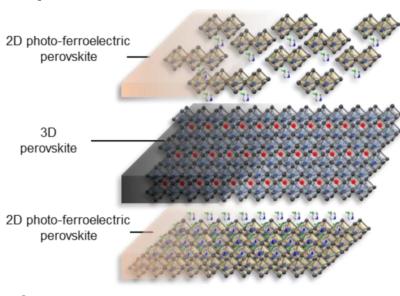Interface engineering plays a significant role in the constant improvement in the performance of perovskite photovoltaics, but such devices still suffer from several issues, including unavoidable open circuit voltage (VOC) losses. Now, an international team of researchers from Università Degli Studi Di Pavia, King Abdullah University of Science and Technology (KAUST), Chinese Academy of Sciences (CAS), University of Cambridge, Istituto Italiano di Tecnologia (IIT), Slovak Academy of Sciences and Imperial College London have proposed a different approach by creating a photo-ferroelectric perovskite interface.
Graphical representation of the 2D/3D/2D perovskite heterostructure. Image from: Nature Communications
By engineering an ultrathin ferroelectric two-dimensional perovskite (2D) which sandwiches a perovskite bulk, the scientists exploited the electric field generated by external polarization in the 2D layer to enhance charge separation and minimize interfacial recombination. As a result, they observed a net gain in the device VOC reaching 1.21 V, the highest value reported to date for highly efficient perovskite PVs, leading to a champion efficiency of 24%.
Modeling reportedly depicts a coherent matching of the crystal and electronic structure at the interface, robust to defect states and molecular reorientation. The interface physics can be finely tuned by the photoferroelectric field, representing a new tool for advanced perovskite device design.


